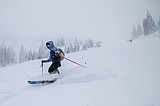Gianforte again pushes for aggressive approach to wildfires at fire briefing
KATE HESTON | Hagadone News Network | UPDATED 2 years, 7 months AGO
Kate Heston covers politics and natural resources for the Daily Inter Lake. She is a graduate of the University of Iowa's journalism program, previously worked as photo editor at the Daily Iowan and was a News21 fellow in Phoenix. She can be reached at [email protected] or 406-758-4459. | May 10, 2023 12:00 AM
Gov. Greg Gianforte asked state agencies Tuesday to prioritize forest management and aggressively attacking all wildfires while emphasizing firefighter safety ahead of the 2023 fire season.
“With every fire we have to respond with one goal and that is to put out the fire as quickly and as safely as possible,” Gianforte said during the annual wildfire briefing in Helena on May 9.
During a round table discussion, land managers from multiple state agencies confirmed their commitment to aggressive action when dealing with wildfires, as well as proactive preventative work such as fuel reduction.
Representatives from the state Department of Natural Resources and Conservation, Department of Environmental Quality, Montana Disaster and Emergency Services, the Montana National Guard and the federal Bureau of Indian Affairs, among others, were in attendance.
The National Park Service also had a representative in attendance, a change from last year. For more than five decades the federal agency has allowed some fires to burn within park boundaries, recognizing fire’s natural role in forest management and forest health. During the 2021 fire briefing, a park representative pushed back against Gianforte’s approach to firefighting — that all fires must be put out aggressively.
This year, park service officials expressed their commitment to aggressively fighting fires alongside the state agencies. According to Paul Cerda, the regional fire management officer for the National Park Service, the agency has conservation crews in Glacier National Park and Yellowstone National Park to deal with active forest management.
Other agency representatives also expressed their commitment to prepare for and aggressively combat wildfires in the state. According to Matt Hall, the fire protection bureau chief at the Department of Natural Resources and Conservation, the agency has already staffed 80% of their seasonal positions and increased wages to $17.55 an hour.
“As Montanans we work and live in forest and grasslands across this state, which means we all have a responsibility to prepare for wildfires,” Hall said at the round table discussion.
Regional forester with the U.S. Forest Service, Leanne Martin said that the federal agency is equal to where they were last year with 2,000 people ready for action. Last year, according to Martin, the Forest Service completed fuel reduction efforts on 100,000 acres across the state.
“As important, if not more important, is the up front work,” Martin said.
Rich Cowger, president of the Montana State Fire Chiefs’ Association, spoke to the preparedness of fire departments at the local level, an important tool in fighting wildland fires because local governments are consistently the first line of defense when a fire sparks.
With 400 local departments in the state and 8,000 firefighters ready, Harvin said that local governments are as prepared as possible.
The briefing came just after the end of the legislative session. Gianforte highlighted legislation passed by lawmakers that will assist with the wildland fire season.
“As a result of this legislative session, we’re investing $30 million in wildfire risk reduction and forest health improvement projects, and an additional $30 million to increase the state’s wildfire response and initial attack capabilities,” Gianforte said, referring to House Bill 883, which is awaiting the governor’s signature.
According to the U.S. Drought Monitor, most of the state is at a D0 or D1 drought level, meaning that areas are only abnormally to moderately dry. However, the Flathead Valley and surrounding areas are rated at a D2 level, meaning that severe drought conditions have taken hold.
The National Significant Wildland Fire Potential Outlook’s predictive services for May 2023 estimates significant wildland fire potential in the Northern Rockies Geographic Area from May to August. Portions of Northwest Montana likely will have below normal activity in May due to snow cover and moist soil, reducing the chances of a pre-green-up fire season.
However, they also report that Northwest Montana’s snowpack levels are below normal overall.
According to the report, the drought conditions west of the Continental Divide are a more recent development that is expected to persist into the summer. Precipitation patterns also show below normal levels in the area as well.
Gianforte ended the briefing urging communities to be prepared and to stay informed. He called on residents to take a role in mitigating fire hazards, whether that be reducing fuels, making sure chains are not dragging on the road, or coming up with emergency plans.
“We can’t prevent fire from starting but we can prepare to deal with it when it does,” Gianforte said. “... The better prepared we are, the safer our communities will be.”
Reporter Kate Heston can be reached at [email protected] or 758-4459.
ARTICLES BY KATE HESTON

Veteran-owned mobile boat repair service anchors down in the Flathead Valley
The Kramers launched Flathead Mobile Marine to use their skills — they have decades of experience performing routine maintenance checks on a variety of boats as well as working with engines and electrical systems — and help boaters in the community.

With ski season near, resort reaches deal with staff
After 18 months of negotiations, Whitefish Mountain Resort executives and the resort’s ski patrol union are finalizing a one-year contract for the upcoming season.

Trapped in a car wreck, Woods Bay woman credits teens with saving her life
Driving home from a quilting event in Bigfork in September of last year, Carol Martin remembered that the sky was clear, the sun was shining, and she had a headache.

